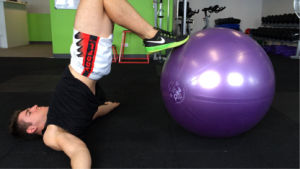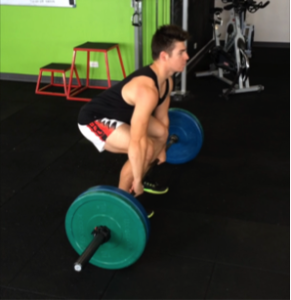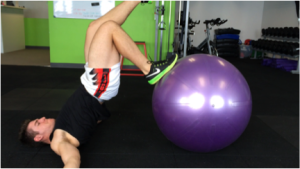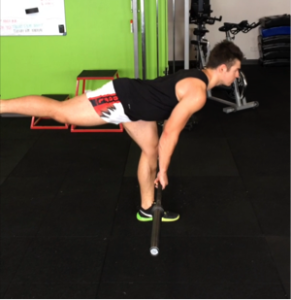Hamstrings and Posterior Chain development for footy
Hamstring strains and tears (or even just tightness) are the scourge of many a footy player. The dynamic nature of footy ensures that your hamstrings will be severely tested throughout a match, and especially over the space of a season when residual fatigue in your muscles starts to kick in. However, the dynamic and challenging nature of footy on these muscles is only 1 part of the problem – the other is the lack of adequate training done to effectively prepare the hamstrings (and posterior chain in general) for the demands of a game of footy.
So not only is conditioning the hamstrings crucial to the performance of various movements that the hamstrings play a big role in – such as jumping, accelerating (in particular the first 5-6 explosive steps to initiate the movement), decelerating as well as in kicking (both legs, not just the leg that’s kicking, but also providing stability on the other side) – but crucial to injury reduction when called into action to perform these tasks.
A common problem when performing a conditioning program of any sort, is to become too anterior chain focused. That is, to become too focused on the muscles at the front of our body that wee see in the mirror, and neglect the all-important posterior. Furthermore, many movements in footy are dominated by the work of muscles on the front of our bodies already – pushing, tackling, jumping, kicking, etc – that by neglecting to put even more of an emphasis on the muscles of the posterior chain in strength training at the expense of the posterior, we are only adding further to an imbalance that will inevitably lead to injury.
In other words, yes it is important to focus on the key muscle groups and movements that we want to strengthen for game day – however this also includes strengthening the opposing muscles to these, in order to maintain proper postural alignment, and balance around our joints.
The hamstrings are 1 part of this posterior chain, but the one most relevant to discussion for footy, due to the high incidence of injury to this key muscle group. The literature that exists out there covering the importance and contribution of functional hamstring training to athletic success is numerous – and some of the best short and simple to follow information out there is written by world renowned strength coach Charles Poliquin. So there is no debating the merit of this key ingredient to both performance and injury reduction – no conditioning experts really debate this point. However, as more and more everyday footballers catch on to this, the problem lies in the type of hamstring work they are doing. In short, just because you are doing a ‘hamstring’ exercise, does not mean it will effectively prepare your hamstrings for the demands of footy, and reduce your chances of injury.
For starters, a lying (or seated depending on the machine) hamstring curl on a machine will do nothing to condition your hamstrings for football, nor will they reduce the likelihood of an injury to your hamstrings. Remembering the concepts of the brain recognising movements not muscles, football being about movement rather than individual muscles, and the importance of the specificity of an exercise in regards to the transfer from training to a match situation, there are many ways we could go to expanding on the limitations to this form of hamstring training in conditioning for a sport like footy. But in the interests of not dragging this discussion on too long and sticking with information that is simple to follow and implement, we will stick to the most important take home points that arise from the above concepts.
The hamstrings are both a knee flexor and a hip extensor – so train both functions
A hamstring curl is a knee flexion, just as a seated leg extension is the opposite – a knee extension. In footy and in life, the hamstrings play a dual role of both this knee flexion (like when kicking a ball) as well as a key role in hip extension (like when jumping or also following through the kick.) Therefore by simply focusing on the knee flexion movement, you are already limiting the functionality of the program, and as a result, both should be trained. So already start thinking; swiss ball hamstring curls for the knee flexion, and deadlifts for the hip extension.


Not to mention a stabiliser
The hamstrings also play a third role on top of the knee flexion and hip extension depending on the situation they are in – and it usually goes forgotten – and that is the role as a pelvic and knee stabiliser. When in certain positions on 1 leg (such a running or especially kicking) the muscles around the hip and knee have a lot more work to now do to stabilise the area – and the hamstrings are no different. So for example, when kicking on your right leg, your right hamstring will be the one you would most likely think of in terms of the work its performing, however the left hamstring must work effectively to contract isometrically to provide sufficient strength for stability on the other side. This is an underrated task, but it shouldn’t be – as evidenced by the number of hamstring injuries in the act of kicking on the non-kicking leg.
You see in movement, as world renowned exercise specialist Paul Chek puts it ‘muscles lose their identity.’ And so to does it lose its textbook definition of its ‘function.’ In other words, when in the process of movement, the brain doesn’t recognise ‘oh yes there’s the hamstring the hamstring is a knee flexor.’ But rather, different muscles lose their identity to particular movement patters or motor programs, and depending on the task being performed, will be called on to perform a range of different functions, not just the ‘knee flexor’ or ‘hip extensor’ minimalistic definitions that are outlined in textbooks (which in fairness are done more for simplicity’s sake, more so than a lack of knowledge on the authors part.)
1 leg at a time – makes a big difference
No talk of lower body athletic conditioning would be complete without briefly covering the fact that the majority of tasks in a game of footy are performed off 1 leg at a time, rather than 2, and as a result, single leg hamstring work is a vital component to effectively prepare for game day and reduce injury to the hamstrings. We cover this single sided discussion and a little more detailed information on this topic elsewhere, but is important to again note it here, and how it ties in to effective and functional hamstring strengthening.


But as a good way of understanding this – take those swiss ball hamstring curls and do them 1 leg at a time, and take those deadlifts and perform them on 1 leg at a time. Obviously loads and sets and reps and tempos must differ for the single leg variety, and proper technique and for is vital in order to get the most out of them, and to ensure you will maximise carryover to match day.
Strength Coach
What are the key hamstring exercises?
How do I program hamstring exercises effectively for footy?

